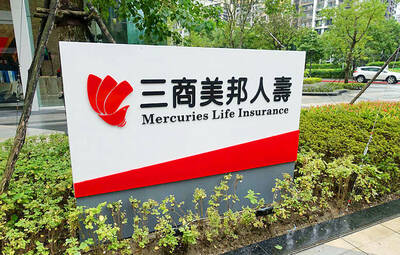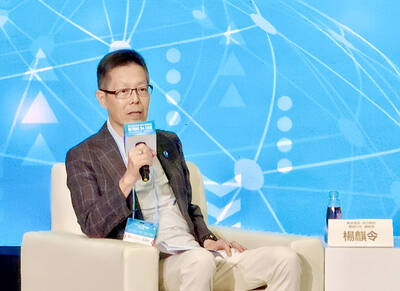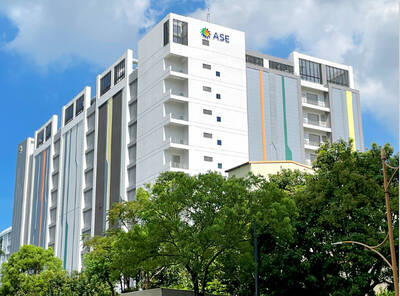Inspired by kitesurfing, French firms want to deploy the same wind technology to propel everything from yachts to cargo ships in order to cut the shipping industry’s massive carbon footprint.
The sector is under fresh pressure to reduce its reliance on fossil fuels as the International Maritime Organization (IMO) sealed a deal on Friday that raises its emissions-reduction targets.
In Arcachon Bay in southwest France, the start-up Beyond The Sea tested a blue inflatable kite sail the size of a small studio to pull a specially designed catamaran across the water.

Photo: AFP
“Are you ready to jibe?” company founder Yves Parlier said, using kitesurfing lingo to speak to this team of engineers steering the 25 square meter kite.
In kitesurfing, riders use their hands to control the kite, but on Parlier’s SeaKite catamaran, an automated traction system is used for the kite, with winches and artificial intelligence that adapts the sail’s position to the wind conditions.
The goal is to design much bigger kite sails that could one day pull yachts, trawlers and even container ships.
“It’s a phenomenal system of traction which allows one to reduce fuel consumption by 20 percent on average,” said Parlier, a former winner of transatlantic sailing competitions.
The potential is huge given that there are nearly 100,000 merchant ships crisscrossing the oceans and 4.6 million fishing trawlers in the world.
The Wind Ship association, which was created in 2019 in France with the aim of greening the maritime sector, says the market could be worth 4 billion euros (US$4.39 billion) by 2030 with around 1,400 vessels fitted with such kites.
In March next year, Beyond The Sea plans to carry out similar tests using its specially designed kites off the waters of Norway and Japan and in the Mediterranean.
The company hopes to double the size of its kites every year, reaching 800 square meters in four years, executive director Marc Thienpont said.
The shipping industry has to find alternatives to fossil fuels, with the IMO on Friday setting a net zero emissions target for “close to 2050,” with progressive reduction goals of at least 20 percent by 2020 and at least 70 percent by 2040 compared to 2008 levels.
While the previous target was for a 50 percent reduction by mid-century, climate campaigners said the decision did not go far enough to help the battle against global warming.
Airseas, another French company in which European aviation giant Airbus SE holds 11 percent stake, is testing a kite spanning 500 square meters — almost twice the size of two tennis courts — which it hopes to double for larger ships.
The company, based in the western city of Nantes, late last year fitted out a bulk carrier belonging to the Japanese firm K. Line, its biggest client, which has placed five confirmed orders for its Seawing.
It has also kitted a roll-on, roll-off ship transporting equipment for A320 planes between the French port of Saint-Nazaire and the port of Mobile in the southern US state of Alabama where Airbus has a factory.
Another alternative solution has surfaced with the French firm Chantiers de l’Atlantique, whose Solid Sail designed for ocean liners is made up of panels fitted to a rigid sail that can be inclined to allow the ships to pass under bridges.
There are also semi-rigid sails manufactured by Ayro and used on the 121-meter-long cargo ship Canopee to transport elements of the Ariane 6 launcher from Europe to French Guiana.
Some new French shipping companies are meanwhile using vessels only harnessing wind power such as Zephyr et Boree, Windcoop, Neoline ou Towt.
“In France, there is a level of operational maturity which allows commercialization” of the adapted kites and sails, Wind Ship’s Lise Detrimont said.
However, if the sector has the wind in its sails, its attractiveness suffers from a price of a barrel of heavy fuel oil currently at its lowest.
“Maritime transport costs nothing until environmental regulations come into force,” Detrimont said.
The carbon-free fuel lobby is also a brake, she said, pointing out that its cost was “five to seven times” higher than conventional fuel oil and advocating its hybrid use along with sailing.
The sector is in talks with the French government to recognize wind as a fuel. Detrimont said that with this in hand, over 30,000 jobs would be created in 2030.

AI BOOST: Although Taiwan’s reliance on Chinese rare earth elements is limited, it could face indirect impacts from supply issues and price volatility, an economist said DBS Bank Ltd (星展銀行) has sharply raised its forecast for Taiwan’s economic growth this year to 5.6 percent, citing stronger-than-expected exports and investment linked to artificial intelligence (AI), as it said that the current momentum could peak soon. The acceleration of the global AI race has fueled a surge in Taiwan’s AI-related capital spending and exports of information and communications technology (ICT) products, which have been key drivers of growth this year. “We have revised our GDP forecast for Taiwan upward to 5.6 percent from 4 percent, an upgrade that mainly reflects stronger-than-expected AI-related exports and investment in the third

Mercuries Life Insurance Co (三商美邦人壽) shares surged to a seven-month high this week after local media reported that E.Sun Financial Holding Co (玉山金控) had outbid CTBC Financial Holding Co (中信金控) in the financially strained insurer’s ongoing sale process. Shares of the mid-sized life insurer climbed 5.8 percent this week to NT$6.72, extending a nearly 18 percent rally over the past month, as investors bet on the likelihood of an impending takeover. The final round of bidding closed on Thursday, marking a critical step in the 32-year-old insurer’s search for a buyer after years of struggling to meet capital adequacy requirements. Local media reports

TECHNOLOGICAL RIVALRY: The artificial intelligence chip competition among multiple players would likely intensify over the next two years, a Quanta official said Quanta Computer Inc (廣達), which makes servers and laptops on a contract basis, yesterday said its shipments of artificial intelligence (AI) servers powered by Nvidia Corp’s GB300 chips have increased steadily since last month, should surpass those of the GB200 models this quarter. The production of GB300 servers has gone much more smoothly than that of the GB200, with shipments projected to increase sharply next month, Quanta executive vice president Mike Yang (楊麒令) said on the sidelines of a technology forum in Taipei. While orders for GB200 servers gradually decrease, the production transition between the two server models has been

ASE Technology Holding Co (日月光投控), the world’s largest integrated circuit (IC) packaging and testing supplier, yesterday announced a strategic collaboration with Analog Devices Inc (ADI), coupled with the signing of a binding memorandum of understanding. Under the agreement, ASE intends to purchase 100 percent shares of Analog Devices Sdn Bhd and acquire its manufacturing facility in Penang, Malaysia, a press release showed. The ADI Penang facility is located in the prime industrial hub of Bayan Lepas, with an area of over 680,000 square feet, it said. In addition, the two sides intend to enter into a long-term supply agreement for ASE to